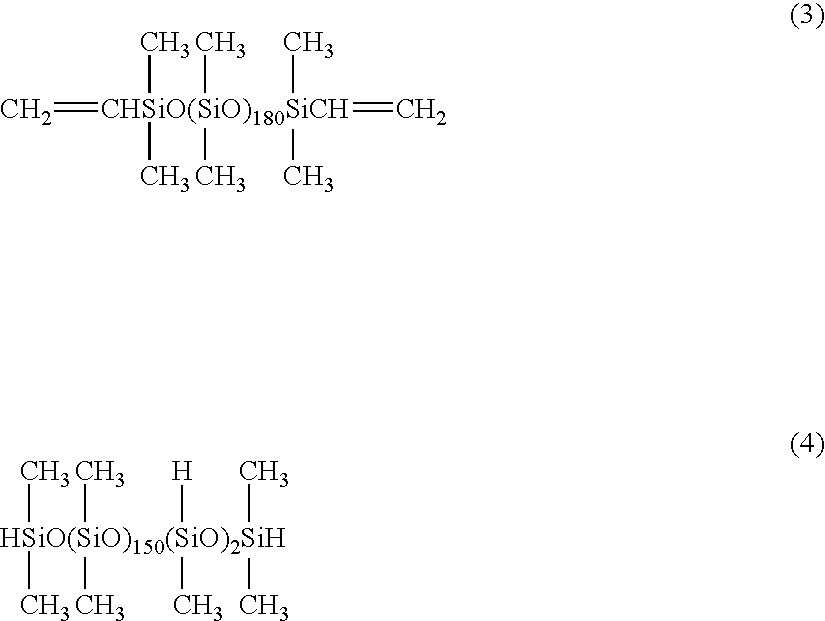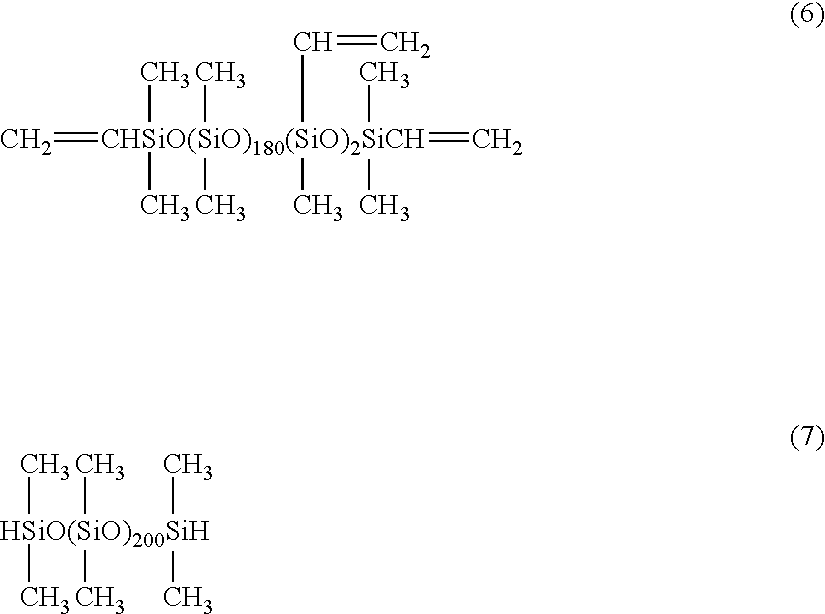Silicone microparticles comprising silicone elastomer spherical microparticles coated with polyorganosilsesquioxane, and method of producing same
a technology of silicone elastomer and spherical microparticles, which is applied in the direction of cellulosic plastic layered products, natural mineral layered products, transportation and packaging, etc., can solve the problems of unavoidable drawbacks of greasiness, stickiness, oily film feeling of cosmetic materials, etc., and achieve the effect of suppressing greasiness, stickiness and oily film feeling
- Summary
- Abstract
- Description
- Claims
- Application Information
AI Technical Summary
Benefits of technology
Problems solved by technology
Method used
Image
Examples
example 1
[0087]A glass beaker with a capacity of 1 liter was charged with 350 g of a methylvinylpolysiloxane A1 represented by formula (3) shown below and having a dimethylsiloxane unit content of 100 mol %, a molecular weight of 13,524 and a vinyl group content of 0.015 mol / 100 g, and 160 g of a methylhydrogenpolysiloxane B1 represented by formula (4) shown below and having a dimethylsiloxane unit content of 98.7 mol %, a molecular weight of 11,369 and a SiH group content of 0.035 mol / 100 g (an amount equivalent to 1.07 SiH groups within the methylhydrogenpolysiloxane B1 per vinyl group within the methylvinylpolysiloxane A1), and stirring and mixing were performed at 2,000 rpm using a homomixer. To the resulting mixed liquid were added 1.2 g of a polyoxyethylene lauryl ether (number of mols of added ethylene oxide=9 mol) and 100 g of water, and subsequent stirring at 6,000 rpm using the homomixer yielded an O / W type emulsion of increased viscosity. Stirring was continued for a further 15 mi...
example 2
[0094]A water dispersion of silicone elastomer microparticles was obtained in the same manner as example 1, with the exceptions of altering the amount of the methylvinylpolysiloxane A1 from 350 g to 270 g, and replacing the 160 g of the methylhydrogenpolysiloxane B1 with 240 g of a methylhydrogenpolysiloxane B2 represented by formula (5) shown below and having a dimethylsiloxane unit content of 99.3 mol %, a molecular weight of 22,484 and a SiH group content of 0.018 mol / 100 g (an amount equivalent to 1.07 SiH groups within the methylhydrogenpolysiloxane B2 per vinyl group within the methylvinylpolysiloxane A1). Inspection of the shape of these silicone elastomer microparticles in the same manner as example 1 revealed spherical particles, and measurement of the volume average particle diameter in the same manner as example 1 yielded a result of 12 μm.
[0095]Using 882 g of the obtained water dispersion of silicone elastomer spherical microparticles as a raw material, a hydrolysis-cond...
example 3
[0100]A water dispersion of silicone elastomer microparticles was obtained in the same manner as example 1, with the exceptions of replacing the 350 g of the methylvinylpolysiloxane A1 with 170 g of a methylvinylpolysiloxane A2 represented by formula (6) shown below and having a dimethylsiloxane unit content of 98.9 mol %, a molecular weight of 13,696 and a vinyl group content of 0.029 mol / 100 g, and replacing the 160 g of the methylhydrogenpolysiloxane B1 with 340 g of a methylhydrogenpolysiloxane B3 represented by formula (7) shown below and having a dimethylsiloxane unit content of 100 mol %, a molecular weight of 14,954 and a SiH group content of 0.013 mol / 100 g (an amount equivalent to 0.90 SiH groups within the methylhydrogenpolysiloxane B3 per vinyl group within the methylvinylpolysiloxane A2). Inspection of the shape of these silicone elastomer microparticles in the same manner as example 1 revealed spherical particles, and measurement of the volume average particle diameter...
PUM
| Property | Measurement | Unit |
|---|---|---|
| volume average particle diameter | aaaaa | aaaaa |
| mol % | aaaaa | aaaaa |
| volume average particle diameter | aaaaa | aaaaa |
Abstract
Description
Claims
Application Information
 Login to View More
Login to View More - R&D
- Intellectual Property
- Life Sciences
- Materials
- Tech Scout
- Unparalleled Data Quality
- Higher Quality Content
- 60% Fewer Hallucinations
Browse by: Latest US Patents, China's latest patents, Technical Efficacy Thesaurus, Application Domain, Technology Topic, Popular Technical Reports.
© 2025 PatSnap. All rights reserved.Legal|Privacy policy|Modern Slavery Act Transparency Statement|Sitemap|About US| Contact US: help@patsnap.com



